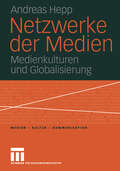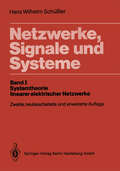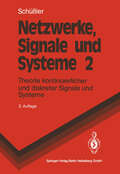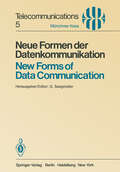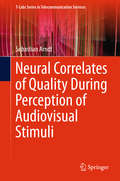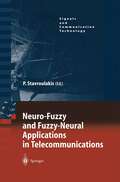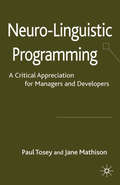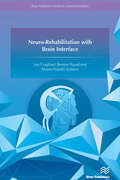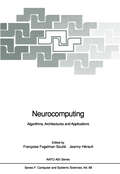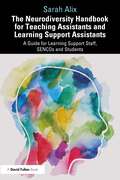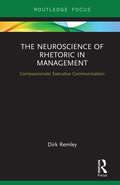- Table View
- List View
Netzwerke der Medien: Medienkulturen und Globalisierung (Medien • Kultur • Kommunikation)
by Andreas HeppAuf Basis der Kritik bisheriger Forschungen wird ein Neuansatz der Beschreibung von Medienkulturen in Zeiten der Globalisierung entworfen. Gegenstand sind hier Netzwerkunternehmen der global orientierten Medienproduktion und globale Medienstädte, weltweite Medienereignisse, über verschiedene Kulturen hinweg verfügbare Produkte unterschiedlichster Medien wie Fernsehen, Film und Internet sowie deren Aneignung in Bezug auf differente kulturelle Kontexte und Medienidentitäten. "Netzwerke der Medien" unternimmt den Versuch, gegenwärtige Medienkulturen in deren Komplexität und Widersprüchlichkeit zu fassen.
Netzwerke, Signale, Systeme: Band 1: Systemtheorie linearer elektrischer Netzwerke
by Hans W. SchüßlerAus den Besprechungen: "...In diesem, den dargebotenen Stoff induktiv aufbauenden Lehrbuch werden viele Überlegungen mit der Betrachtung oftmals auch praktisch interessanter Beispiele begonnen, wobei über die Spezifik hinaus allgemeine Zusammenhänge gesucht werden. Eine große Anzahl der Beispiele werden noch durch Meßkurven veranschaulicht. Auf eine kurze Literaturliste am Ende eines jeden Kapitels wird gezielt verwiesen. Dieses sich durch eine einheitliche Darstellung auszeichnende gut lesbare Lehrbuch kann nicht nur Studenten der entsprechenden Semester des Elektrotechnik-Studiums, sondern auch anderen, an einem Zugang zu diesen Problemen interessierten Studenten sehr empfohlen werden." #ZAMM Zeitschrift für angewandte Mathematik und Mechanik#1
Netzwerke, Signale und Systeme: Theorie kontinuierlicher und diskreter Signale und Systeme (Springer-Lehrbuch)
by Hans W. SchüßlerAus den Besprechungen: "...In diesem, den dargebotenen Stoff induktiv aufbauenden Lehrbuch werden viele Überlegungen mit der Betrachtung oftmals auch praktisch interessanter Beispiele begonnen, wobei über die Spezifik hinaus allgemeine Zusammenhänge gesucht werden. Eine große Anzahl der Beispiele werden noch durch Meßkurven veranschaulicht. Auf eine kurze Literaturliste am Ende eines jeden Kapitels wird gezielt verwiesen. Dieses sich durch eine einheitliche Darstellung auszeichnende gut lesbare Lehrbuch kann nicht nur Studenten der entsprechenden Semester des Elektrotechnik-Studiums, sondern auch anderen, an einem Zugang zu diesen Problemen interessierten Studenten sehr empfohlen werden." #ZAMM Zeitschrift für angewandte Mathematik und Mechanik#1
Netzwerke, Signale und Systeme: Theorie kontinuierlicher und diskreter Signale und Systeme (Hochschultext)
by Hans Wilhelm SchüßlerNeue Formen der Datenkommunikation / New Forms of Data Communication: Vorträge des am 1./2. Juli 1980 in München abgehaltenen Symposiums / Proceedings of a Symposium Held in Munich July 1/2, 1980 (Telecommunications #5)
by G. SeegmüllerNeue Impulse für die soziologische Kommunikationstheorie: Empirische Widerstände und theoretische Verknüpfungen
by Thomas Malsch Marco SchmittWährend die empirische Kommunikationsforschung durch die Entwicklungen des Internets und anderer mobiler Kommunikationsformen an Bedeutung weiter zunimmt, befindet sich die Kommunikationstheorie auf der Suche nach neuen Impulsen. Die Beiträger dieses Bandes gehen davon aus, dass sich eine produktive Weiterentwicklung der soziologischen Kommunikationstheorie nur bewerkstelligen lässt, wenn man sie öffnet, indem man sie mit empirischen Widerständen konfrontiert oder Verknüpfungsmöglichkeiten mit anderen Theorieparadigmen erarbeitet.
Neue Märkte durch Multimedia / New Markets with Multimedia: Vorträge des am 30. November und 1. Dezember 1994 in München abgehaltenen Kongresses / Proceedings of Congress Held in Munich, November 30 and December 1, 1994 (Telecommunications #21)
by Jörg EberspächerMultimedia ist nicht nur ein Schlagwort - es ist da! Die Vision wird Wirklichkeit: Die Informations- und Kommunikationsmedien Sprache (Audio), Bild (Video) und Text/Daten/Grafik wachsen zusammen. Die Beiträge zu diesem Werk beleuchten dieses faszinierende Thema aus verschiedenen Blickwinkeln: Zunächst wird eine grundsätzliche Standortbestimmung mit Diskussion der wirtschaftlichen und ordnungspolitischen Hemmnisse bei der Einführung von Multimedia durchgeführt. Dann stellen sich verschiedene Branchen und Sektoren vor, in denen wesentliche Impulse für und durch Multimedia erwartet werden. Konkrete Erfahrungsberichte stehen dabei im Vordergrund. Weitere Themen waren Wissensvermittlung und -beherrschung durch Multimedia, die Rolle der Netze und Datenbanken sowie "Mensch und Multimedia".
Neue Plattformen – neue Öffentlichkeiten: KI, Krisen und Journalismus
by Gabriele Hooffacker Wolfgang Kenntemich Uwe KulischAlgorithmen und Künstliche Intelligenz wie die generative Sprach-KI ChatGPT übernehmen journalistische und publizistische Aufgaben – bei der Recherche, bei Produktion und Distribution. Wie ist es um die Zukunft des Journalismus unter den rasant sich verändernden Rahmenbedingungen bestellt? Worauf müssen sich Medienschaffende und Rezipienten einstellen? Wie können Medien auch in Krisenzeiten möglichst unabhängig bleiben und weiterhin Voraussetzung für eine funktionierende Demokratie sein? Der Band versammelt Beiträge zur Fachtagung "Neue Plattformen – neue Öffentlichkeiten" im September 2023 an der HTWK Leipzig.
Neue Wege zur Schlüsselqualifikation Schreiben: Autonome Schreibgruppen an der Hochschule
by Katrin GirgensohnKatrin Girgensohn untersucht autonome Schreibgruppenarbeit im Sinne des 'Shift from Teaching to Learning' und den Ausbau von selbststeuerndem Lernen an der Universität, um Studierende effektiv beim Ausbau ihrer Schreibkompetenzen zu unterstützen.
Neuorientierung im Wirtschaftjournalismus: Redaktionelle Strategien und Publikumserwartungen
by Claudia MastDie aktuelle Finanz- und Wirtschaftskrise belegt, wie der Wirtschaftsjournalismus immer mehr in eine Schlüsselposition für die öffentliche Kommunikation rückt. Er liegt im Schnittfeld zweier gesellschaftlicher Trends – der Mediatisierung und Ökonomisierung vieler Lebensbereiche. Das Buch analysiert die Verantwortung und Grundlagen des Wirtschaftsjournalismus, untersucht Bedingungen und Arbeitsweisen der Macher und legt Nutzungsmuster sowie Erwartungen des Publikums offen. Damit entsteht eine systematische Bestandsaufnahme der Strategien, Konzepte und Verantwortlichkeiten des Wirtschaftsjournalismus sowohl aus Perspektive der Forschung als auch in berufspraktischer Hinsicht.
Neural Correlates of Quality During Perception of Audiovisual Stimuli (T-Labs Series in Telecommunication Services)
by Sebastian ArndtThis book presents a new approach to examining the perceived quality of audiovisual sequences. It uses electroencephalography (EEG) to explain in detail how user quality judgments are formed within a test participant, and what the physiological implications might be when subjects are exposed to lower quality media. The book redefines the experimental paradigms of using EEG in the area of quality assessment so that they better suit the requirements of standard subjective quality testing, and presents experimental protocols and stimuli that have been adjusted accordingly.
Neural Networks: Methodology and Applications
by Gérard DreyfusNeural networks represent a powerful data processing technique that has reached maturity and broad application. When clearly understood and appropriately used, they are a mandatory component in the toolbox of any engineer who wants make the best use of the available data, in order to build models, make predictions, mine data, recognize shapes or signals, etc. Ranging from theoretical foundations to real-life applications, this book is intended to provide engineers and researchers with clear methodologies for taking advantage of neural networks in industrial, financial or banking applications, many instances of which are presented in the book. For the benefit of readers wishing to gain deeper knowledge of the topics, the book features appendices that provide theoretical details for greater insight, and algorithmic details for efficient programming and implementation. The chapters have been written by experts and edited to present a coherent and comprehensive, yet not redundant, practically oriented introduction.
Neural-Symbolic Learning Systems: Foundations and Applications (Perspectives in Neural Computing)
by Artur S. d'Avila Garcez Krysia B. Broda Dov M. GabbayArtificial Intelligence is concerned with producing devices that help or replace human beings in their daily activities. Neural-symbolic learning systems play a central role in this task by combining, and trying to benefit from, the advantages of both the neural and symbolic paradigms of artificial intelligence. This book provides a comprehensive introduction to the field of neural-symbolic learning systems, and an invaluable overview of the latest research issues in this area. It is divided into three sections, covering the main topics of neural-symbolic integration - theoretical advances in knowledge representation and learning, knowledge extraction from trained neural networks, and inconsistency handling in neural-symbolic systems. Each section provides a balance of theory and practice, giving the results of applications using real-world problems in areas such as DNA sequence analysis, power systems fault diagnosis, and software requirements specifications. Neural-Symbolic Learning Systems will be invaluable reading for researchers and graduate students in Engineering, Computing Science, Artificial Intelligence, Machine Learning and Neurocomputing. It will also be of interest to Intelligent Systems practitioners and anyone interested in applications of hybrid artificial intelligence systems.
Neuro-Fuzzy and Fuzzy-Neural Applications in Telecommunications (Signals and Communication Technology)
For the first time, this highly interdisciplinary book covers the applications of neuro-fuzzy and fuzzy-neural scientific tools in a very wide area within the communications field. It deals with the important and modern areas of telecommunications amenable to such a treatment.
Neuro-Linguistic Programming: A Critical Appreciation for Managers and Developers
by P. Tosey J. MathisonAddressing the need for a discerning, research-based discussion of NLP, this book seeks to answer the many questions that clients, potential users and practitioners ask, including: what is NLP and what can it best be used for? This book looks at the research and theory behind NLP, also exploring claims that it is a `pseudoscience'.
Neuro-Rehabilitation with Brain Interface
by Leo P. Ligthart Ramjee Prasad Silvano PupolinIn recent years, major results were reported on Brain-Computer Interface / Brain-Machine Interface (BCI/BMI) applied to rehabilitation in scientific reports and papers. This subject received much attention within the Society on Communication, Navigation, Sensing and Services (CONASENSE) during the period 2013-2015. Describing the state of the art on various BCI/BMI activities related to neuro-rehabilitation is the central theme of this book.The latest insights coming from neurophysiologists, neuropsychologists, ICT experts specialized in clinical data management and from representatives of patient organizations are elucidated and new ways for “BCI/BMI applied to rehabilitation” using advanced ICT are introduced. The book describes the latest progress in and is an appeal for an approach leading to more cost-saving multi-disciplinary neuro-rehabilitation. This book covers the following topics: • Overview on BCI/BMI applied to rehabilitation• ICT for Neuro-rehabilitation• ICT for new generation prostheses• Gaze tracking, facial orientation determination, face and emotion recognition in 3D space for neuro-rehabilitation applications• Integrated perspective for future wide spread integration of motor neuro-rehabilitation• Ethical issues in the use of Information and Communication Technologies in the health care of patients with neurological disorders
Neuro-Rehabilitation with Brain Interface
In recent years, major results were reported on Brain-Computer Interface / Brain-Machine Interface (BCI/BMI) applied to rehabilitation in scientific reports and papers. This subject received much attention within the Society on Communication, Navigation, Sensing and Services (CONASENSE) during the period 2013-2015. Describing the state of the art on various BCI/BMI activities related to neuro-rehabilitation is the central theme of this book.The latest insights coming from neurophysiologists, neuropsychologists, ICT experts specialized in clinical data management and from representatives of patient organizations are elucidated and new ways for “BCI/BMI applied to rehabilitation” using advanced ICT are introduced. The book describes the latest progress in and is an appeal for an approach leading to more cost-saving multi-disciplinary neuro-rehabilitation. This book covers the following topics: • Overview on BCI/BMI applied to rehabilitation• ICT for Neuro-rehabilitation• ICT for new generation prostheses• Gaze tracking, facial orientation determination, face and emotion recognition in 3D space for neuro-rehabilitation applications• Integrated perspective for future wide spread integration of motor neuro-rehabilitation• Ethical issues in the use of Information and Communication Technologies in the health care of patients with neurological disorders
Neurocomputing: Algorithms, Architectures and Applications (NATO ASI Subseries F: #68)
by Francoise Fogelman Soulie Jeanny HeraultThis volume contains the collected papers of the NATO Conference on Neurocomputing, held in Les Arcs in February 1989. For many of us, this conference was reminiscent of another NATO Conference, in 1985, on Disordered Systems [1], which was the first conference on neural nets to be held in France. To some of the participants that conference opened, in a way, the field of neurocomputing (somewhat exotic at that time!) and also allowed for many future fruitful contacts. Since then, the field of neurocomputing has very much evolved and its audience has increased so widely that meetings in the US have often gathered more than 2000 participants. However, the NATO workshops have a distinct atmosphere of free discussions and time for exchange, and so, in 1988, we decided to go for another session. This was an ~casion for me and some of the early birds of the 1985 conference to realize how much, and how little too, the field had matured.
The Neurodiversity Handbook for Teaching Assistants and Learning Support Assistants: A Guide for Learning Support Staff, SENCOs and Students
by Sarah AlixThis highly practical book supports the knowledge and development of teaching assistants and learning support assistants (TAs/LSAs) in their understanding of neurodivergent pupils. Considering a neurodivergent world is vital in society today, and even more so in the classroom. Starting with a model of difference rather than deficit and highlighting the complexities involved, this accessible resource focuses on effective strategies to support these pupils and explores the vital role of learning support in a range of different contexts. Rich in pedagogical features, this book includes chapter objectives, areas for the reader to reflect upon, links throughout to the Teaching Assistant Standards and case studies for the reader to examine. Each chapter also has a further reading section which will include links to articles, websites, and organisations that can aid and support the development of TAs and LSAs. This important work will provide Special Educational Needs Co-ordinators (SENCos) with a framework to support their support staff in the classroom.
The Neurodiversity Handbook for Teaching Assistants and Learning Support Assistants: A Guide for Learning Support Staff, SENCOs and Students
by Sarah AlixThis highly practical book supports the knowledge and development of teaching assistants and learning support assistants (TAs/LSAs) in their understanding of neurodivergent pupils. Considering a neurodivergent world is vital in society today, and even more so in the classroom. Starting with a model of difference rather than deficit and highlighting the complexities involved, this accessible resource focuses on effective strategies to support these pupils and explores the vital role of learning support in a range of different contexts. Rich in pedagogical features, this book includes chapter objectives, areas for the reader to reflect upon, links throughout to the Teaching Assistant Standards and case studies for the reader to examine. Each chapter also has a further reading section which will include links to articles, websites, and organisations that can aid and support the development of TAs and LSAs. This important work will provide Special Educational Needs Co-ordinators (SENCos) with a framework to support their support staff in the classroom.
The Neuroscience of Multimodal Persuasive Messages: Persuading the Brain (Routledge Studies in Technical Communication, Rhetoric, and Culture)
by Dirk RemleyIn this book, Dirk Remley applies his model of integrating multimodal rhetorical theory and multi-sensory neural processing theory pertaining to cognition and learning to multimodal persuasive messages. Using existing theories from multimodal rhetoric and specific findings from neurobiological studies, the book shows possible applications of the model through case studies related to persuasive messages such as those found in political campaign advertising, legal scenarios and general advertising, including print, videos, and in-person settings. As such, the book furthers the discussion of cognitive neuroscience and multimodal rhetorical theory, and it serves as a vehicle by which readers can better understand the links between multimodal rhetoric and cognitive neuroscience associated with persuasive communication in professional and educational environments.
The Neuroscience of Multimodal Persuasive Messages: Persuading the Brain (Routledge Studies in Technical Communication, Rhetoric, and Culture)
by Dirk RemleyIn this book, Dirk Remley applies his model of integrating multimodal rhetorical theory and multi-sensory neural processing theory pertaining to cognition and learning to multimodal persuasive messages. Using existing theories from multimodal rhetoric and specific findings from neurobiological studies, the book shows possible applications of the model through case studies related to persuasive messages such as those found in political campaign advertising, legal scenarios and general advertising, including print, videos, and in-person settings. As such, the book furthers the discussion of cognitive neuroscience and multimodal rhetorical theory, and it serves as a vehicle by which readers can better understand the links between multimodal rhetoric and cognitive neuroscience associated with persuasive communication in professional and educational environments.
The Neuroscience of Rhetoric in Management: Compassionate Executive Communication (Routledge Focus on Business and Management)
by Dirk RemleyExecutives continue to lose their position because of inability to communicate organizational decisions to employees and boards effectively. More than just the words one writes or speaks, communication includes one’s actions and other non-verbal attributes that carry meaning for audiences. Further, decisions may affect these audiences differently emotionally and economically, complicating communication with each group. This book provides case studies to illustrate communication failure that directly resulted in executives' termination. These case studies include the fields of higher education, health care administration, computer technology, medical research, news media, and advertising. Synthesizing scholarship in neuroscience about how the brain processes information from verbal, visual and other stimuli as well as management and communication principles found in books valued in leadership development programs, this book explains why audiences reacted negatively to messages and describes how the messages could have been delivered to get a better response. The book includes rubrics to assist readers develop their own messages. Executives and those in leadership development programs will benefit from this book.
The Neuroscience of Rhetoric in Management: Compassionate Executive Communication (Routledge Focus on Business and Management)
by Dirk RemleyExecutives continue to lose their position because of inability to communicate organizational decisions to employees and boards effectively. More than just the words one writes or speaks, communication includes one’s actions and other non-verbal attributes that carry meaning for audiences. Further, decisions may affect these audiences differently emotionally and economically, complicating communication with each group. This book provides case studies to illustrate communication failure that directly resulted in executives' termination. These case studies include the fields of higher education, health care administration, computer technology, medical research, news media, and advertising. Synthesizing scholarship in neuroscience about how the brain processes information from verbal, visual and other stimuli as well as management and communication principles found in books valued in leadership development programs, this book explains why audiences reacted negatively to messages and describes how the messages could have been delivered to get a better response. The book includes rubrics to assist readers develop their own messages. Executives and those in leadership development programs will benefit from this book.
The Neutrality Trap: Disrupting and Connecting for Social Change
by Jacqueline N. Font-Guzmán, PhD, JD, MHA. Bernard S. MayerWork for social change through constructive engagement and systems disruption in this practical resource for social change advocates and conflict specialists In The Neutrality Trap, expert mediators and facilitators Bernard Mayer and Jacqueline N. Font-Guzmán deliver an insightful and practical exploration of how to understand the conflicts we face as social change agents. You'll learn about systems disruption and constructive engagement: how to develop the relationships and change strategies that help people, systems, and societies confront their most important social challenges. In this important book, you will: Discover how to challenge the status quo in an effective way Practice how to "get into good trouble," and pick the battles worth fighting Learn to be strategic in your approach to social change and sustain your efforts over the long term Perfect for anyone interested in progressing and achieving social justice, The Neutrality Trap is an indispensable guide to engaging in and managing the necessary conflict that comes with meaningful change.
